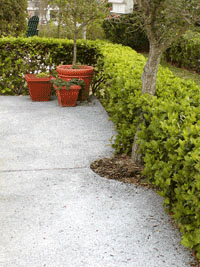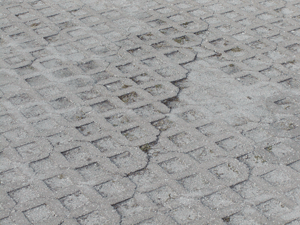Pervious Concrete Reduces Problems
- It may reduce or eliminate the need for subterranean storm sewer drains. Pervious concrete not only eliminates much of the run off from pavements, but may also catch the runoff from roofs and return it to the aquifer.
- Trees are great tools in fighting the greenhouse effect. Unlike impervious pavements, Pervious Concrete lets water and oxygen enter the soil below. This allows tree roots to perform their tasks efficiently. Those tasks include cooling the surrounding air by the evaporation of the captured ground water. This helps reduce air conditioning costs.
- Pervious Concrete because of its Solar Reflectivity Index of about 29 absorbs much less heat than asphalt and with its water retention it reduces the load on air conditioning.
- Finally for the developer or engineer, it makes possible maximum land use for parking lots, roads, and structures. With certified engineering it can reduce the size of retention areas. Storm drains may be eliminated and some curbing as well. For watershed and estuary areas it is an environmental tool to keep these waters clean and cooler. These are ecological as well as dollars and cents issues.

Trees thrive as Pervious Concrete allows rain water to reach their roots.
As the water is drawn up to the leaves or blades of grass the miracle of transpiration converts it back to vapor which helps create more rain while cooling surrounding air.
Why is Pervious Concrete superior to other pervious pavement materials?
- Pervious Asphalt
- Pervious asphalt is black or grey. It absorbs more of the suns rays and converts them into heat. This heat helps create urban heat islands, which encourages the formation of ozone, nitrogen oxide and smog.
- Pervious asphalt has a tendency to creep at high temperatures. This encourages the formation of ruts from vehicle weight and ridges from vehicle braking. Its asphalt binders will adhere to silt and pollutants and will soon lose porosity. To stabilize it, pervious asphalt is often placed over an impervious base, making its primary advantage noise reduction, not water conservation.
- Pervious asphalt is dependent on oil as a feed stock. After placement, oil byproducts release V.O.C.s (Volatile Organic Chemicals) which pollute the air.
- Pervious Concrete Paver Blocks.
- Though these function well in residential driveways, installation is labor intensive.
- The weight of heavy vehicles can cause cracking.
- The weight of heavy vehicles on roadways will also cause settling and shifting. Maintenance issues prohibit installation over sand. If installed over impervious surfaces, they will look better longer, but they will lose their function of channeling rain water to the aquifer.
- Oil and grease seem to be more of a problem than with Pervious Concrete.
- Masonry Grass Blocks
- Grass blocks do not allow as much rainwater through because the concrete they are made from is impervious.
- Oil and grease droppings kill grass.
- Mowing and fertilizing are needed. Maintenance cost is higher. Many times grass is replaced with sand.


